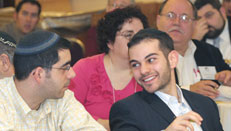 |
||||||||||||
| Weekly Parsha | ||
| Current Week | ||
| Parsha Archives | ||
| Business Ethics | ||
| Dr. Malamet Speaks Out | ||
| TiM MP3 Library | ||




A Thought for the Week with Rabbi Jay Kelman
|
 The Torah uses its words sparingly. Many key laws -- such as the details of what is forbidden on Shabbat , the description of tefillin , how to slaughter animals, and how to distribute charity are only hinted at or not even mentioned at all. We must rely on the oral law, which together with the written text of the Chumash was received by Moshe on Shavuot . Yet strangely enough the Torah devotes 89 verses to describing the gifts that the leaders (princes) of each tribe brought to the newly dedicated mishkan. Moreover each leader brought exactly the same gift and still the Torah enumerates each individual gift, repeating the same paragraph 12 times. Is it really necessary to record it an additional eleven times? The Torah is teaching us a very important lesson regarding building a community that is based on service to G-d. Each person is important as a unique individual, not just a cog in the collective machine. Every gift is important and is worthy of mention in the Torah . Yet each individual ought to have as his or her intent to do what is best for the community. This means doing mitzvot not for personal honour or glory but rather to fulfil the will of G-d. The princes did not try to outdo each other with bigger and better gifts but were content to share the credit in building the mishkan . A bigger gift may have received more recognition on a personal level but would tend to dissolve the feeling of unity, which had developed among the 12 equal tribes. Religious one-upmanship is to often manifest in our generation. Religious practice is at times dictated not by a sincere desire to carry out G-d's will but by currying to or worrying about the reaction of our neighbours. In order to prove our piety, we look for new and often stricter interpretations of Jewish law. The more we can distinguish ourselves from our less observant brethren, the more our religiosity stands out. Instead of the religious unity displayed by the leaders in the desert, we have a fragmented community in which, for many, unity is not even a goal. The Rabbis in the Talmud were wary of newfound religious stringency. They declared that once a practice has been established, a later generation is not to question its religious legitimacy. Therefore the Talmud disallows a certain stringency in the laws of Gittin (divorce) -- even though an improperly executed Get renders any subsequent marriage adulterous and any children illegitimate -- as that would imply that previous Gittin were invalid. The mere implication of irregularities of the prior generations did not allow the stringency to gain Rabbinic approval. Similarly the Terumat Hadeshen , writing in the 14th century in Germany, would not even listen to arguments that a long-standing Eiruv was invalid. Since it was built with the approval of the Rabbis of the previous generations, questioning its validity would represent an unwarranted attack on the authority of prior generations. Not to use such an Eiruv would declare that in your eyes the Jews of previous generations were violators of Shabbat , a view that can't be countenanced. There is no doubt that our generation continues to see increased meticulousness and stringency in the application of Jewish law, as compared with the previous generation. The access to a solid Jewish education that was not available to many of our parents and grandparents has enabled us to more fully apply Halacha to our lives. There was laxity in the observance of many mitzvot , but often it was due to simple ignorance. The increased observance in these areas of laxity is therefore something to be proud of, reflecting the maturity of Jewish life on these shores. On the other hand, some of the practices that were sanctioned by the great Rabbis of the previous generations have also come under attack. Instead of reflecting greater piety this may show a religious insecurity and ignorance for the sacredness of established practice. As we strive to fully implement Torah values in our lives we must find the proper balance between the past and the present. Shabbat Shalom! |
|
|

 |
 |